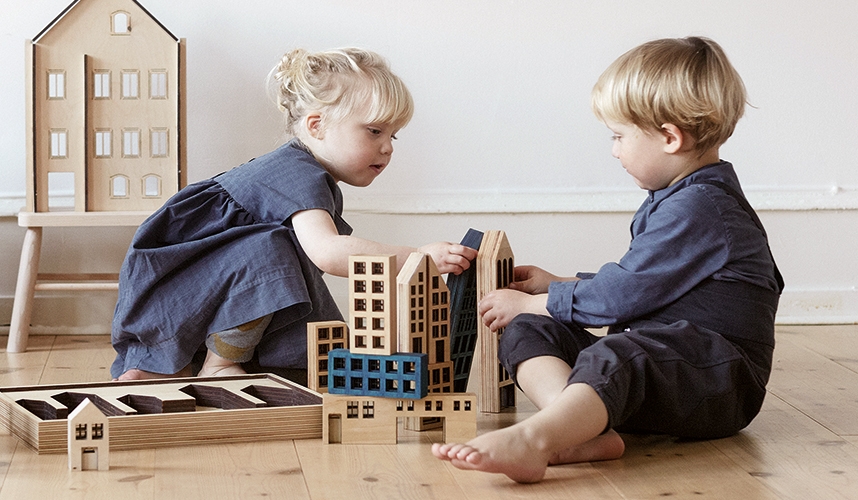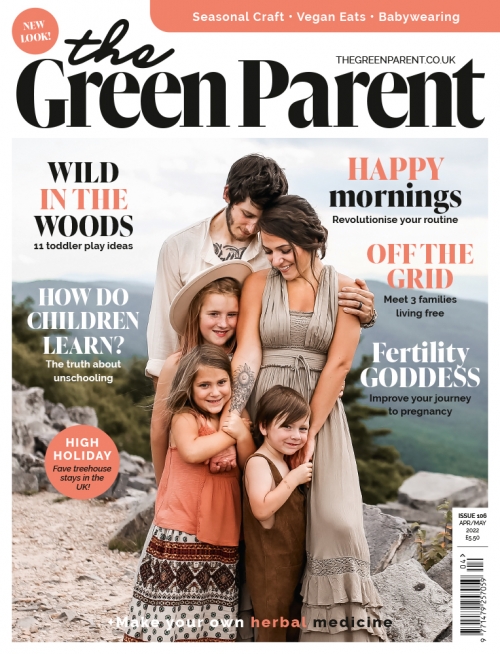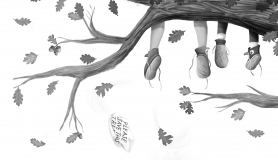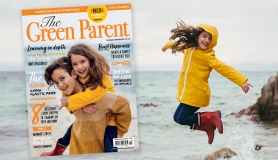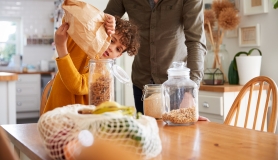Creating memories
Dora Botta lives in London with her partner and their two children, close to charity shops where she chooses secondhand playthings, and encourages gifts of experiences rather than more toys to create family connection
Plastic toys are everywhere. They are inexpensive, vibrant and heavily marketed so no wonder our kids are drawn to them. They are destined for landfill as they are typically composed of other materials too, like metals, rendering recycling almost impossible. Toys typically serve one role and can’t be repurposed. My other issue with plastic toys is how short lived they are. They turn up at birthdays and holidays, in gift bags at parties and even inside cereal boxes. These types of trinkets often occupy our child’s attention for a short amount of time and then get discarded. Or, the playthings are made from such insufficient materials that they’ll fall apart after just a few uses and quickly wind up in the bin.
Less is more
Obviously, my kids love toys and we don’t want to deprive them of play. We adopt a ‘less is more’ approach to prevent overwhelm. There are studies that confirm our decision – one states that, “fewer toys can lead a young child to focus and engage in more creative, imaginative play.” I’ve witnessed that. I’ve watched my kids play happily at home with one or two toys then seen them distracted and overwhelmed by choice at a soft play area, or a Montessori class, where toys are in abundance. Having fewer toys means playthings are enjoyed for longer. We encourage our kids to focus better, explore and play more creatively. We rotate toys by storing a box in the attic for a couple of months and then switching it around. Another study explains, “if we rotate toys and books, the brain is given the opportunity to engage fully in what is available without being over stimulated.” We also ask family members to only gift secondhand toys, or experiences over physical toys.
Stocking up
We do have some plastic toys but they are bought second hand 90% of the time. We are in a (maybe lucky?!) position of living next to three charity shops overrun with toys. I usually pop in once a week or so to scout for Christmas or birthday presents. Once or twice a month I go with my children and they can choose something themselves.
When buying something new I always think of transportation, labour, energy, packaging, resources and all that goes into production. While I like the idea of ethically made toys, we mostly opt for second-hand ones disregarding what they are made of - plastic, wood or metal. Same goes for clothing, kitchen appliances, books or any items we ever need. Charity shops can be hit and miss so when looking for something specific, I search on eBay or Facebook marketplace. The 10% toys we have which aren’t plastic are made of wood. Toys made of wood are timeless, durable and encourage imagination. A firm favourite is our balance board from creatimber.
Using nature
During our walks in the woods we collect leaves, stones and sticks to take home. A long branch becomes a dinosaur tail and stones are parts of the construction toy set to build roads and houses. These items are also perfect for arts and crafts like painting or gluing. Using natural items creates less waste and teaches resourcefulness and helps develop creativity. Crafting creates confidence, knowing they can use their bodies with practical purpose, being able to act on their ideas with confidence in their belief system of “I can do things”. Developing an inner awareness that good things often take time to create, and that the process of making is every bit enjoyable as the product once it is finished.
Making memories
We are a huge believer of memories over things. When it comes to building family happiness we spend time with our sons over buying them new things. We work to create bonding rituals and traditions so they can look back on and cherish these memories instead of automatically heading to the shop to buy another toy or gadget. We have monthly library visits, fortnightly baking and weekly cycling adventures as well as daily reading and puzzle or lego building. Follow Dora’s journey to zero waste in each edition and on Instagram @mamoradiary.
“Toys made of wood are timeless, durable and encourage imagination”
Keeping imagination alive
Kristina Madsen lives with her partner and their two children in Bedfordshire. Passionate about wooden toys she recommends a few of her favourites for open ended, imaginative play
Is that a wooden spoon?!’ The lady at the baby clinic stared at my four month old baby happily munching a wooden spoon, in disbelief. Magnus was very easily entertained as a baby, happiest when given free reign in the kitchen drawers. And so his trusted spoon came along wherever he went. Handed down from my grandmother, this spoon has served its purpose many times over, only to end its days being gnawed to bits by a teething baby. I knew I wanted wooden toys before I even wanted children. I’ve been told that my grandmother used to bring home wooden spools and buttons from the yarn shop where she worked, and I would sit and play with them for hours on end, content and happy with the simplicity of the offering and creating a world out of the smallest things.
Choosing Handmade
When my children came along, what started off as a sensitivity to sound, and aversion to light up plastic toys, quickly spiralled into a world of wooden, handmade, open-ended and ethical toys. Our toy collection kicked off with a handmade wooden dumper truck, crafted by my then 12 year old brother at school, which is still played with every day, four years later. With the imminent arrival of our rainbow baby, Mali, I was searching for a toy to gift to Magnus and found the Grimm’s rainbow. An avalanche of wooden toys began pouring into our home. Which I realise in hindsight wasn’t very ethical of me, but I was addicted and couldn’t stop. The fact that these toys were open ended and have no age limit, means that as my children grow - so does their imagination and the play opportunities. Luckily my children love them as much as I do! Barely a day goes by without Magnus using the Grimm’s rainbow in play; stacking, building, and knocking it over. I feel as though I’ve been given a second chance at childhood, letting my creativity unfold alongside my childrens’, which really proves that these toys are ageless! I will always prioritise play before anything else as the children are little for such a short time. I’m trying to soak up every moment and make the most of this precious time.
Keeping it Interesting
I’ve found that a regular rotation of their toys is necessary to keep the magic alive. Since we first started collecting, the amount of toys have drastically reduced, but even with fewer toys I still find toy rotation beneficial, with the kids seeing the toys in a different light and therefore their play will take a different direction every time. We definitely have favourite brands; Grimms, for example, is a German manufacturer of handmade, wooden and natural toys. Grapat is a Spanish family-run business creating a diversity of loose parts toys (and my personal favourite - mandala pieces) to perfectly accompany small world play. Wobbel make balance boards, designed to let children grow and play without limits, in Germany. Plan Toys are perhaps the most ethical of all toy manufacturers. Situated in Thailand, they create their toys from rubber wood, where nothing goes to waste and even the sawdust gets turned into toys designed to last (almost) forever. Ostheimer is a family business crafting wooden figurines from sustainably sourced wood, perfect for small world play and play based learning. And the TriClimb created, designed and manufactured in Wales - is the children’s favourite toy. It offers a variety of play opportunities and encourages children to climb and discover through their own abilities. From a slide in the garden on a sunny day or a cosy den when the clouds announce their arrival, its possibilities are limitless! What all these companies have in common is that they care about the environment and sustainability, and ensure that everyone involved in their chain of production is treated fairly. Maybe now it’s not so hard to see why I fell head first down this wonderful rabbit hole in the first place.
The Natural World
Many of our toys are second hand. It’s important to me that my children see second hand toys as valuable as those you can buy new, and sometimes their value is heightened due to their history. Our Plan Toys dolls house has been loved at least three times over, and despite the small marks and repairs the kids love it! Alongside toys, we incorporate a lot of natural resources, such as conkers, pinecones, shells and sticks. Mixing them with toys makes for a great opportunity to show the children the play-value nature has to offer. We don’t just keep the fun and play at home - Magnus is currently attending a gorgeous Montessori school nearby, and it was only when stumbling across it by accident that I realised that much of the activities we were doing at home were Montessori based already.
Since discovering the work of Maria Montessori and seeing the positive impact it has had on Magnus we had a tricky time finding a mainstream school which kept to the ethos of play based learning and treating children as individuals, whilst allowing them to learn in natural surroundings. Luckily we’ve found somewhere that ticks our boxes. The school’s ethos, the teachers’ and headteacher’s passion and enthusiasm, alongside forest school opportunities give me every reason to believe he’ll thrive. As for Mali - the day she takes his place at the Montessori school is going to be the happiest day of her life.
Follow Kristina on Instagram @littlemissmamma.
The right path
Teal McGurk has two children aged one and six months. She lives with her family in Northern Ireland and is considering home education for her two children
As a family with two children under two years old, school and formal education isn’t a concern for my husband, David and I, yet. David grew up in Northern Ireland so he understands it but I’m still trying to wrap my head around the education system here compared to what I knew growing up in Canada. In Montreal, education is bilingual and much less selective than here. Pupils are not classified into high school or grammar school based on grades and academic performance in Canada. To me, the fact that that happens here seems illogical and totally unfair at the age of eleven. I’m a teacher by trade and for that reason I tend to look at it through a magnifying lens. With Silas and Aura, I really haven’t a clue what direction we’ll head in. I have considered homeschooling them because I feel they’d be given the opportunity to grow as individuals and learn things that school doesn’t teach like exploring the outdoors and general life problem solving. On the flip side, I’m worried about the isolation homeschooling may bring. I do know quite a few home ed families here and they make up quite a great community together. It feels as though schools mould children into a system and focus solely on being book smart. One really important part of educating my children is that they are bilingual. I grew up speaking two languages and went on to learn four more so my kids having access to two or even three from a young age is a priority for us as a family.
Choosing ethical
Although we don’t have to worry about education right now, toys are certainly a big component in early education for our kids. When Silas was born last year, one of the first things David and I tried to do was to crack down on the ridiculous amount of toys and stuffed animals that can be accumulated, especially in the first year. We told family and friends we either preferred wooden or second hand toys. We discovered two pretty cool brands for relatives who found it challenging to buy used items - Plan Toys and Green Toys. Both companies make new toys from recycled plastic from oceans or around the world. One of the best toys you can give a child is the outdoors. With a little imagination, they can create a world of their own and learn so much more. I’m sure like many of you who have tried to lead a minimal waste lifestyle, one of the hardest parts has been teaching other family members about our lifestyle. From clothes to toys, they ALWAYS want to buy more for the kids and at the end of the day, it ends up unused or in the charity pile. I’m keen to hear how other readers tackle this.
Get in touch with Teal on Instagram @doyourbit.ni to share stories and tips
Image: Kolekto Wooden Architectural Building Blocks - bluebrontide.com

